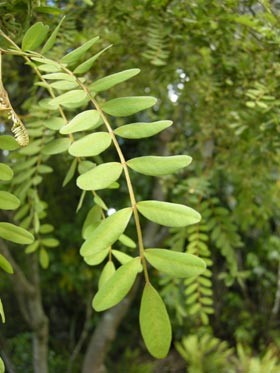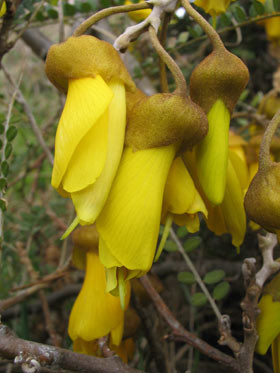
 There are approximately 45 species of Sophora worldwide. The New Zealand botanic region has eight native species, Sophora microphylla being the most widespread, and two naturalised exotic - Sophora cassioides (Chilean pelu) and Sophora howinsula (Lord Howe kowhai).
There are approximately 45 species of Sophora worldwide. The New Zealand botanic region has eight native species, Sophora microphylla being the most widespread, and two naturalised exotic - Sophora cassioides (Chilean pelu) and Sophora howinsula (Lord Howe kowhai).
All kowhai species have leaves consisting of numerous small leaflets paired along the leaf stem. Kowhai species range from bushes with interlacing (divaricating) branches to small trees up to 15 m in height and two species (Sophora microphylla and S. tetraptera) are brevideciduous. Sophora microphylla (left, by John Barkla) and Sophora tetraptera (right, by John Sawyer)
Flowering occurs in the late winter to early spring (September) when a flush of bright yellow flowers occurs. The Sophora genus is found throughout New Zealand although some species are restricted in distribution such as Sophora fulvida, Sophora longicarinata and Sophora molloyi.
New Zealand Sophora were reviewed in 2001 (see Heenan et al. 2001). Kowhai is a Maori word meaning yellow and many species have medicinal uses, for example a solution obtained from boiling the bark or the leaves was used on cuts, wounds and infections. However, all parts of the kowhai plant should be considered poisonous if ingested.
For more information abotu kowhai see*:
- Kowhai (Wikipedia)
- Sophora (Wikipedia)
- Kowhai (University of Auckland - Faculty of Science)
- The Kowhais of New Zealand by Denis Hughes
- Heenan P.B, de Lange P.J, Wilton A.D. (2001) Sophora (Fabaceae) in New Zealand: taxonomy, distribution and biogeography. New Zealand Journal of Botany 39:17-53
*The Network is not responsible for the content of external internet sites
